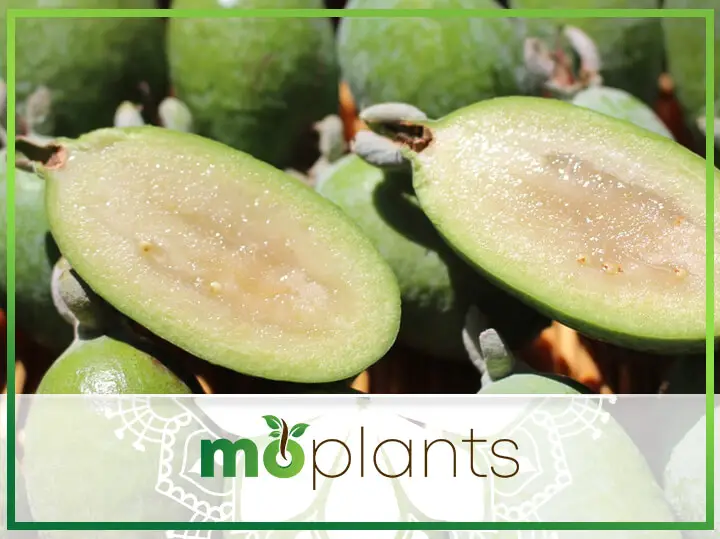The pineapple guava is one of the most underrated fruit trees, which is unbelievable considering how resilient it is! It has a unique taste that is incredibly yummy, both sweet and slightly tart.
If you are curious about what the pineapple guava is and want to see if you can grow it yourself, read on. This guide will tell you all you need to know!
What Is Pineapple Guava?
Pineapple guava is also referred to as Feijoa Sellowiana (Fay-joe-ah) or Acca Sellowiana.
The pineapple guava is native to South America, particularly southern Brazil, Uruguay, western Paraguay, and certain parts of Argentina.
Despite its name, it is not a real guava. It is a member of the Myrtle plant family, with feijoa being a distant cousin of the tropical guava.
It was introduced to New Zealand, Europe, and the US during the early 1900s.
The feijoa sellowiana is exceptionally adaptive, as long as temperatures do not fall lower than 15°F. It prefers subtropical climates to thrive, with cold, mild winters and moderate summers in the 80 – 90s.
This means the pineapple guava is one of the most cold-resistant types of guava that you can grow, as it can survive average temperatures even as low as 15°F.
It requires at least 50 days of chill to get the flowering flowing. In California coastal areas, especially in San Francisco, some commercial planting is being done. It is also commonly found in landscaping.
Portland is another place that has excellent conditions for growing the pineapple guava feijoa, particularly in the south-facing position against a hardscape or building in the Pacific Northwest.
Today, this plant variety is regularly grown in different parts of the United States, Europe, Mexico, Australia, and New Zealand.
Why Should You Grow Your Own Feijoa?
Easy to Grow
They are low-maintenance, pest-resistant, drought-tolerant, and easy to train as either a shrub or tree.
It naturally has a multi-branched form. But it is easy to shape it as a single trunk or even form an espaliered tree.
With proper care, time, and plenty of patience, you can make it grow as high as 20 feet!
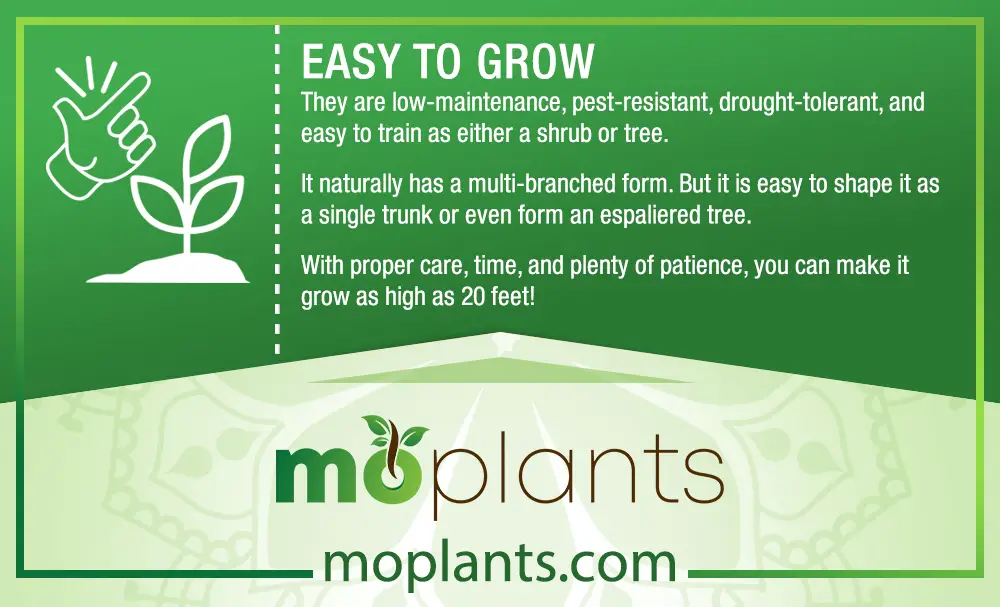
Delicious and Healthy
Both the fruit and the flowers are edible and delicious. The pineapple guava is also rich in vitamin C, fiber, antioxidants, and all the vital Bs your doctor tells you that you need!
The edible white sepals are thick cloud-like pillows of sweet cotton candy that will melt in your mouth.

Gorgeous Aesthetics
The pineapple guava can grow up to 12 to 15 ft. The top of the leaves is glossy and dark green. The underside of the foliage is fuzzy with a bright silver color. This is why landscape artists plant the feijoa for aesthetics.
It is full and evergreen, so you can plant them close together to create an excellent privacy screen. It can also function as an effective, edible way to break strong winds!
Birds love nesting on the pineapple guava tree or shrub. Note that its small branches can be very brittle, despite the density of the wood, so they can snap when birds stand on them.
Pineapple guava flowers are tremendous explosions of red, with delicious edible pink to white sepals surrounding the outside of the flower. It will add a gorgeous splash of color to your garden.
When the flowers come on during spring, the bush becomes a magnificent explosion of color and fireworks. It is covered in white and red on the backdrop of green leaves.
Finally, its beauty extends to its scent. The smell and fragrance of the pineapple guava are beyond description. It is a mere preview of the delicious new growth that will make your mouth water.

Infographic

What Do Pineapple Guavas Taste Like?
To really get the taste of pineapple guava, you will have to try it out yourself. It would taste even better after all that time and hard work! But we will do our best to give you a good idea of what to expect.
It has a unique flavor that is very sweet while being slightly tart at the same time. Imagine drinking a shale of pineapple, banana, kiwi, and guava all at once, with a hint of piney mango or mint. That’s the closest we can get to describing it.
In a nutshell, they are incredibly delicious!
How Pineapple Guavas Grow
After the spring bloom, this plant’s fruit will develop over the summer and ripen in the fall. Typically, one feijoa will grow to the approximate size of a medium to large egg or about 1 to 4 inches with an oblong shape.
It usually takes several years for an immature pineapple guava tree to start bearing a good yield of feijoa for the first time.
However, this can vary depending on your climate, cultivar, and type of plant.
What You Will Need to Get Started
A Good Location
Choose a place that has the best growing conditions for your plant. These plants are not big fans of high winds, so choose a location that is protected from that.
We highly recommend planting your plant near a wall or fence to shelter it from the winds. This will also allow heat to reflect onto the plant and give it additional protection from the frost in areas with challenging and cold winters.
Make sure that the site receives at least half a day to a full day of sunlight, with afternoon summer shade or overall filtered sunlight to protect it from too much heat, as its fruit can get sunburned.
They are known to grow well in California, the Pacific Northwest, Texas, Florida, and more. It is also great for coastal zones, as it can deal with the salty spray and mildly saline soils.
Not Too Hot, Not Too Cold
The feijoa will be happiest in full sun, especially where the average summer temperatures are below 90°F and winter temperatures are above 15°F.
Prolonged periods below 15°F can kill your feijoa plant.Moreover, sudden fall frosts can damage its ripening fruit. Late spring frosts can also destroy the flower blossoms even before they can bear the fruit you worked so hard for.
If you experience a sudden cold snap, you can drape your tree or shrub with a bedsheet, burlap, plastic, or frost blanket to protect it.
Excessive heat can also cause stress and negatively impact its fruit production. It may result in underdeveloped feijoas or loss of its flowers.
According to expert cultivators, your location should ideally have only moderately warm summers and relatively warm winters for the best-tasting feijoa.
Even if you do not have the most ideal of growing conditions, they will still generally thrive. So make sure you do not experience long periods of those temperatures, and you should be okay.
The Right Soil
The pineapple guava prefers sandy loam, well-drained soil with a lot of organic matter. You can also grow them in clay soils, as long as they are not saturated in the wintertime. The plants can even grow in average garden soil!
We highly recommend adding good quality compost to the soil before planting. Finally, add an inch or two of mulch around the base of your tree shrub to protect its shallow roots.
PRO TIP!
The only type of soil that these plants will not tolerate is continuously soggy soil. This is why you must make sure your site is well-drained.
If you naturally have poorly-draining soil, add horticultural sand, small volcanic rock, pumice, or other aeration additives to improve drainage.
You can also add some aged compost, worm castings, and/or high-quality bagged potting soil to enrich the nutrient content of the earth.
The Best Variety of Feijoa for You
Different species of the pineapple guava plant have various characteristics. Some are self-fertile, while others need partner plants for generating a good fruit harvest.
All pineapple guava varieties are hardy and can survive extreme heat and cold, from 15 to 100 degrees Fahrenheit on average.
However, they also vary in terms of the climates and conditions they need to thrive and reach their maximum growth potential.
Choose the best variety for your climate and location if you want the best chances for good growth and yield.
Step #1: Plant Your Pineapple Guava
How Many Should You Plant?
One thing you need to take consider when planting your pineapple guava is whether you want to eat the harvest from your tree and, if so, you will need a lot of them.
This will determine the number and proximity of plants you will need.
You see, the pineapple guava plant is generally self-fruitful or self-pollinating. However, this will not give you much fruit, if any.
While there are certain grafted self-fertile varieties, like the Coolidge, Pineapple Gem, and Apollo that do not need Parker plants to grow fruit, this is not so for all types.
Cross-pollination from a partner plant will drastically increase its fruit development and yield. So, if you want a big harvest from your tree, plant at least two shrubs or trees near one another.
The closer they are to one another, the better cross-pollination will be. However, if this cannot be done, then it is sufficient that they are within the same yard or general space.
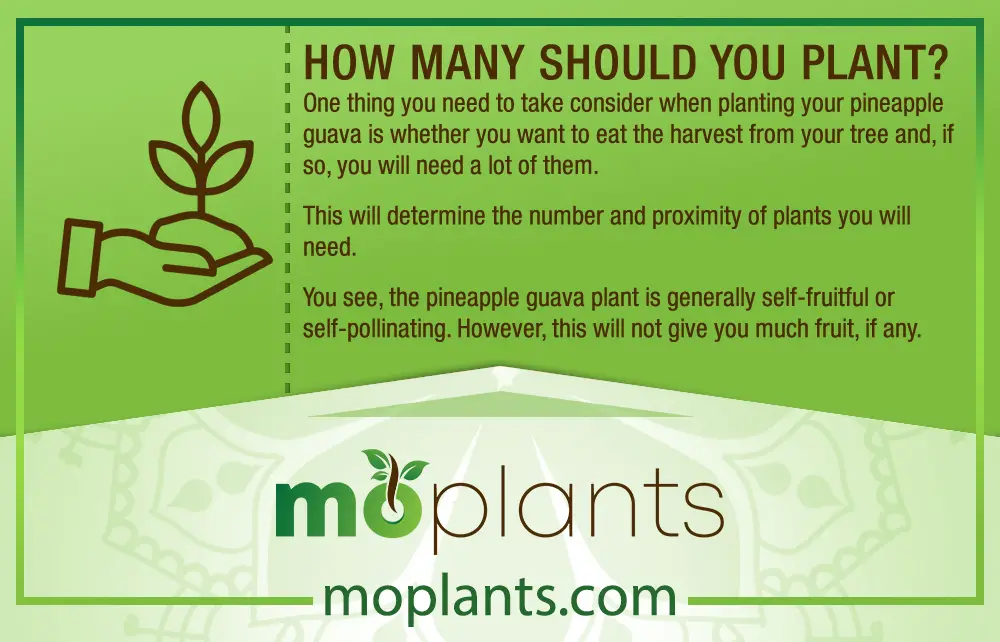
Spacing
This will significantly depend on the amount of space you have available.
If you plan on creating an orchard, it is best to space each plant 8 to 10 feet apart with at least 15 feet between the rows.
For your personal garden or home, you can plant them closer and in hedgerows, even up to just five close apart.

Can I Grow Them in a Container?
Yes, absolutely! Pineapple guava plants are slow-frown in nature. They are also quite lenient to pruning, which makes this plant very container-friendly.
Choose a proper-sized container that will let your pineapple guava grow into the size and with the vigor that you want.
You should ensure there are sufficient drainage holes and high-quality potting soil to promote your plant’s healthy growth.
However, note that we still recommend planting them on the ground to get the best results and better quality feijoa.
We know not everyone has the space or luxury of doing that, so who are we to deny you this lovely fruit?
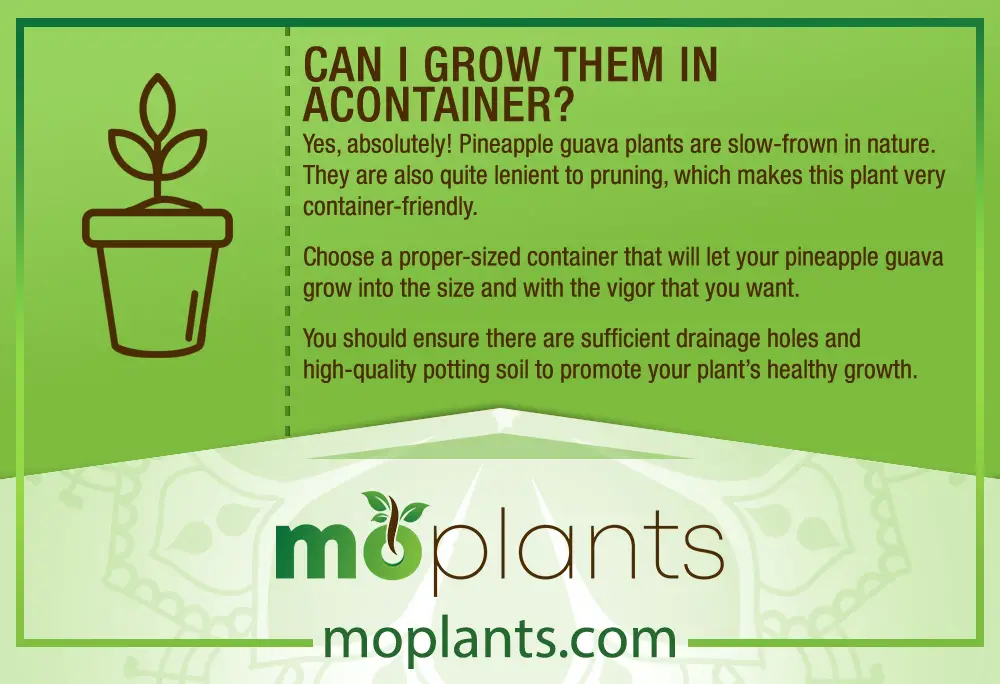
A Note on Pests
You may be wondering why we do not have a section on how to keep pests away from your feijoa.
This is because they are pest and disease-free! Rare instances have reported scale or fruit flies being a problem, but they are so rare that you need not worry!
Step #2: Feed Them!
Pineapple guavas are ravenous plants. They are heavy feeders that require good quality compost mulch and regular additions of a balanced fertilizer to maintain production and replenish its nutrients.
Mulching will ensure that the shallow roots remain protected as well. Adding compost to the soil is recommended. The pH should be approximately 5.5 – 7.0.
We recommend adding slow-release, well-balanced fertilizer around the base of your plant at once or twice a year. Then, add a fresh layer of compost mulch, too.
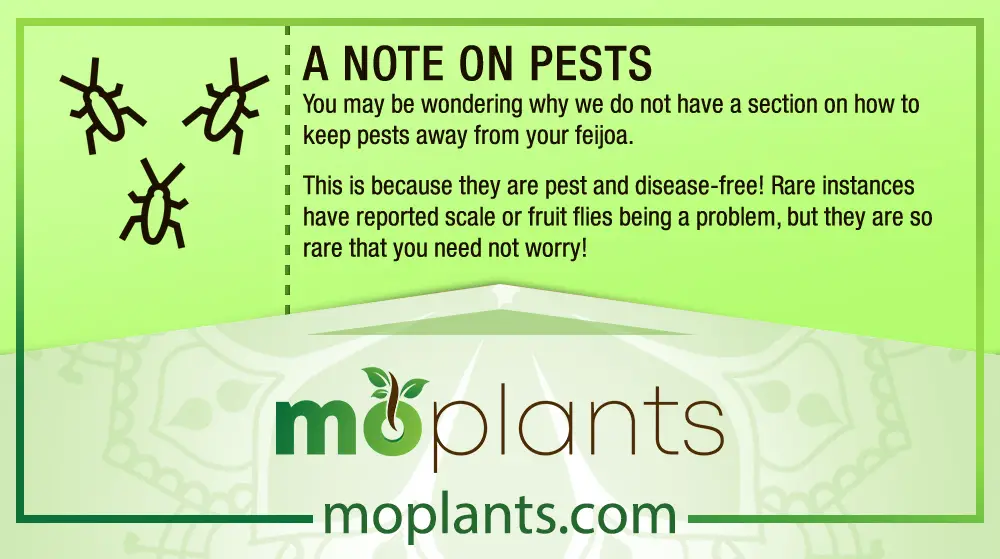
Step #3: Water Them!
While pineapple guava plants are drought-tolerant, they still need to be watered regularly to create a sound root system in the soil. After the initial three years or so, they can survive dry summers without irrigation.
However, if you want to eat yummy feijoa, then deep weekly watering during flowering through fruit formation is absolutely essential.
This is because when the plant feels any stress, it will abort the fruit and diminish its yield to conserve its nutrients for survival.
We recommend keeping the soil damp and mount, but not soggy. Moderate watering is advisable. Avoid overwatering, especially during the winter months, as overly wet soil can lead to rotten roots and other related diseases.
An under-watered plant will result in a feijoa that is not as juicy as you may want, and it can fall from the plant before becoming fully developed.
Step #4: Pollination
As we have stated in the earlier section, your pineapple guava can either self-pollinate or use a partner plant and pollinators. Birds and bees mainly pollinate the pineapple guava.
However, you can also help your plant through hand-pollination. To do this, get a brush, such as a paintbrush or makeup brush, and brush the flowers of your pineapple guava to collect pollen.
Then, go to the other pineapple guava shrub or tree and brush those flowers to transfer the pollen you collected. Keep doing this back and forth.
Step #5: Pruning (Optional)
Pruning is not necessary when growing your pineapple guava. However, in commercial production, the plant is pruned into a single leader with an inverted umbrella shape and an open center.
You do not need to do it this way. Let light and air penetrate the canopy to help ripen the fruit for greater chances of success.
Some prefer to hedge their plants, which will still give you a moderate amount of yield.
Be careful not to prune too much in the summer so you can avoid fruit that will get sunburned.
Step #6: Harvest Time!
You have spent hours in your garden and years waiting to taste that precious fruit finally. Your labor of love has yet paid off. Now how do you harvest the fruits?
Depending on where you live, the season, climate, etc., your fruit will ripen at different times and in stages over a few weeks or up to a month. So, the best way to get your fruits is not to pick them.
Put a net, tarp, sack, or any cloth down and shake the tree until you get those ripe fruits to fall on their own.
However, if you really cannot wait for this, then you can pick them by touch. A mature fruit should be soft to the touch. In any event, you can let your fruit fully ripen on the counter after you have picked it.
Infographic

What to Do After You Have Harvested Them
A freshly plucked feijoa fruit can only survive for a few days. That is good news for you if you are excited to eat your fruit!
If you have an overabundance of fruits, you can turn it into a shake, tap, fruit preserve, juice, or smoothie.
You can even bake with it or make a freeze-dried version. Honestly, the sky is the limit with this delicious fruit.
However, it is still best enjoyed fresh and on its own. So you can also store your fruit in the refrigerator, though take note that its quality can rapidly decrease within a matter of weeks.
How to Eat Your Feijoa Fruit
We recommend cutting one end off just deep enough to reveal the\clear jelly-like center. Then, use a spoon to scoop out the pulp inside. In doing this, you should aim to run the spoon as close to the skin as possible.
The skin is often very tart and tannic, sometimes with stone-like granules that need to be cooked to dissolve.
The extracted pulp is like a sweet and slightly tart dessert, but the skin can be eaten or used, too. In fact, some people use the skin to make jams and jellies. Mmmm, yummy!
There are some thin-skinned varieties of this self-fertile plant that you can eat whole.
Final Words
The feijoa sellowiana is a plant that will keep on giving. It will add a burst of color and design to your garden, give off a mouth-watering sweet scent, and can double as a privacy screen for you.
Moreover, it requires almost nothing but time to grow, as long as you have the right conditions for it to thrive.
And after all that patience and time, you can partake of its sweet, juicy harvest. You can even enjoy it year-round by preserving it in various dishes and preserves.
Whether you are looking for a new design addition or edible plant to your garden, the feijoa has something for you.

